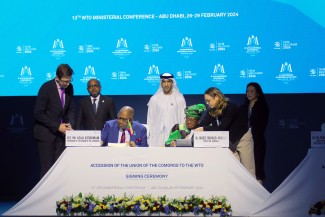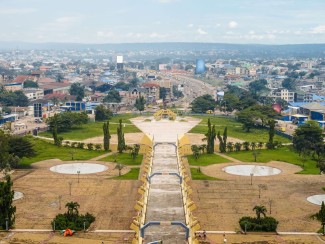Originally published in World Economic Forum Agenda.
- 1.4 billion people worldwide live in the Least Developed Countries, but just 36% of them are connected online.
- These countries risk falling behind on digital transformation, which could hold their economic and social progress back for decades.
- A growing body of evidence shows how international funding, combined with efforts at the national level, can be used to expand internet access and close the digital divide.
Digital technology touches every aspect of human lives and all the UN Sustainable Development Goals (SDGs). While digital transformation can help the 45 Least Developed Countries (LDCs) to sidestep traditional development pathways, the real challenge is the growing digital divide between the LDCs and the rest of the world.
As richer parts of the world become increasingly adept at leveraging digital technology for value creation, the LDCs risk falling further behind.
In recognition of this dilemma, the 2030 Agenda set an ambitious target (SDG 9c) aimed at achieving "universal" and "affordable" access to the internet in the LDCs by 2020. The year 2020 has come and gone, but the target remains unmet, except for in Bangladesh and recently-graduated Bhutan. This is a clear signal to the LDCs and the international community to act urgently. Digital transformation in the LDCs is indispensable now more than ever before.
The opportunity of digital transformation
The LDCs have tremendous opportunities to expand access to affordable digital technologies. For example, in the manufacturing sector, many LDCs still use analogue technology for nearly 70% of the manufacturing process that could potentially be digitalized.
Also, most of the new frontier technologies that have the potential to fuel a green economic transformation are powered by digital technologies. As the total market value of these technologies is likely to increase from $1.5 trillion in 2020 to $9.5 trillion in 2030, the LDCs need to catch up fast, before the relatively narrow window closes for them.
Further, even in the social sector, the adoption of digital technology can help close the access gap. For example, the global telemedicine market, valued at $60.8 billion in 2022, is expected to reach $225 billion by 2030. Similarly, the market for online education, worth around $217 billion in 2022, is likely to hit the $475 billion mark by 2030.
The barriers to digital transformation
The LDCs face several challenges that constrain their ability to harness their digital potential.
Internet access
Access to, and affordability and quality of, electricity and the internet are extremely limited in the LDCs. The LDC electrification rate is 52% (compared to a 90% global average), with more than 500 million people in the LDCs having no access to electricity.
Although 83% of the 1.4 billion people who live in the LDCs are covered by mobile broadband signals (3G or above), only 36% are connected online. Coverage of fixed-line broadband remains abysmally low in LDCs, with only 1.6 subscriptions per 100 inhabitants in 2022. The price of a benchmark mobile broadband basket comprising a 2GB monthly allowance amounts to almost 6% of the average monthly income in the LDCs, four times the global average.
Moreover, the LDCs charge a hefty tariff on Information and Communication Technology products (six times the OECD average), including devices used for internet browsing. It costs 95% of an average monthly income in the LDCs to purchase a smartphone.
Educational attainment
The LDCs in general have a lower level of educational attainment and skilled workforce trained on science, technology, engineering and mathematics (STEM). Worse still, their exposure to digital skills enhancement opportunities has been limited.
The policy environment
Many LDCs lack both enabling policies (e.g., to enhance affordability), which help the state, firms and individuals take advantage of the digital opportunities. They also lack mitigating policies (e.g., to protect privacy), which help overcome obstacles emanating from the use of digital technology.
How to close the global digital divide
Considering these challenges, a few pathways — derived from concrete initiatives — could be followed by the LDCs to change course and leapfrog into digital technologies:
For infrastructure, an innovative approach that stands out is the Mozambique-Malawi Interconnector project to link Malawi to the Southern African Power Pool via a newly constructed power transmission line. The project leveraged the fibre-optic capacity required to operate the transmission line to increase digital connectivity in both countries. Kreditanstalt für Wiederaufbau mobilized €108 million from multiple sources through an innovative financing mechanism combining grants and loan.
Another example of innovative financing comes from a pioneering project in Nepal implemented by WorldLink Communications having received a $15.3 million impact investment from British International Investment and the Dolma Impact Fund. WorldLink accelerated internet expansion to hard-to-reach areas with reliable and affordable internet service, supporting the growth of the rural economy and small- and medium-sized enterprises in Nepal.
Moreover, the Digital Trade for Africa initiative jointly launched by the WTO and the World Bank on the margins of the 13th Ministerial Conference of the WTO last month in Abu Dhabi could be a game-changer for many African LDCs. Through this initiative, LDCs such as Benin, Burkina Faso, Rwanda and Togo, which have joined it, can attract sizeable investment on digital infrastructure.
Policies have a major role to play. For example, imposing universal service obligations to internet service providers (ISPs) to provide a minimum volume of data for free and charging prices above the threshold could help significantly boost affordability.
Similarly, a competition policy aimed at telecom companies can significantly reduce cost, as seen in LDCs like Bangladesh, Bhutan, Cambodia and Nepal, which are among the top 25 cheapest countries for mobile data. LDCs considering joining the WTO Information Technology Agreement to cut the cost of devices and equipment by reducing their tariff on IT products can follow the examples of other LDCs such as Lao PDR and Timor-Leste.
When it comes to STEM education, the commitment made at UNLDC5 for the establishment of an online university for the LDCs focusing on STEM education, especially for women and girls, can play a critical role.
In relation to skills development, a pathbreaking Technology Makers Lab initiative currently being implemented by the UN Technology Bank for Least Developed Countries in Niger and Togo can be a game-changer. This initiative provides training in the skills of the future for the youth in these countries.
Without having to reinvent the wheel, LDC governments should commit themselves to digital transformation with strong political will, and the international community should provide them with the support necessary to help them close the digital gap.
Thanks are due to H.E. Prof. Muhammadou M.O. Kah, Ambassador and Permanent Representative to the WTO, Permanent Mission of the Republic of The Gambia, Geneva, for a helpful discussion on this article.
If you would like to reuse any material published here, please let us know by sending an email to EIF Communications: eifcommunications@wto.org.


